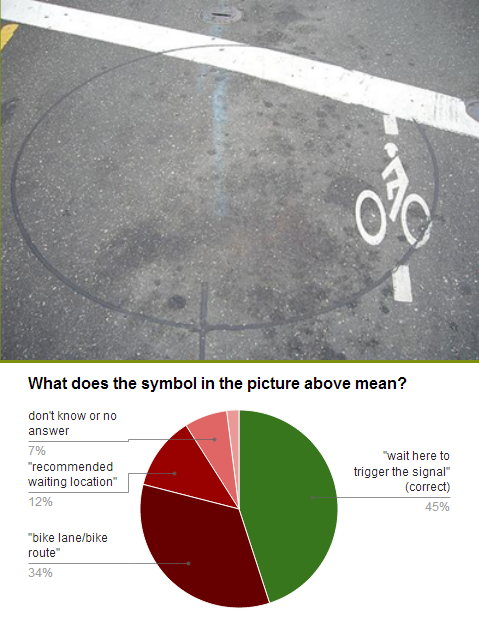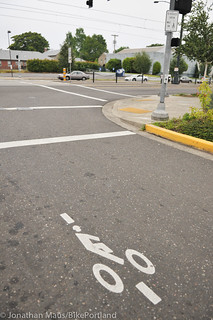The pavement marking to the right, which is supposed to tell people where to place the wheels of their bike to trigger a green light, is illegible to about half of Portland bikers, a new study (PDF) finds.
Even worse: Those figures don’t include many people who rarely ride, suggesting that interminable red lights are a particular burden on new bike riders.
Stefan Bussey, a PSU civil engineering student who conducted the survey, said he came up with the idea when he noticed that people ahead of him at the long Seven Corners traffic signals on Southeast Division would regularly stop a few feet away from the traffic signal stencil.
“It would happen three or four times a week,” Bussey said.
Bussey’s research confirmed it: even in Portland, about 55 percent of bicycle riders surveyed don’t know the meaning of the pavement marking.

of bike riders who thought it meant “bikes allowed.”
Photo from Bussey, graph by BikePortland)
Portlanders seem to be doing better than Floridians. A study of 68 Tallahassee residents last year found that zero of them knew what the above stencil, which is a national standard road marking, means.
The Portland findings are based on analysis of 302 hours of video footage and a combination of 227 in-person and online surveys. Of the survey respondents, 65 percent said they ride a bicycle at least three times a week.
More than a third of those said they’d wait for a traffic light by standing within 10 feet of the curb, even at an intersection with a marked bike detector near the middle of the street. Survey data also suggested those riders were motivated by a desire to stay “out of the way” of traffic, Bussey said — suggesting that red lights are a particular burden to less experienced riders.
From his video footage, Bussey found that explanatory road signs and green coloring behind the stencils can both draw attention better than white stencils alone, though the behavior change wasn’t dramatic.
“I don’t think it’s fair to really expect people to understand how traffic signals operate. We don’t expect [motor] vehicles to know where they’re supposed to wait.”
— Stefan Bussey, Portland State University
“I don’t think it’s fair to really expect people to understand how traffic signals operate,” Bussey said in a seminar last week presenting his results. “We don’t expect vehicles to know where they’re supposed to wait to get a green, so ideally we won’t expect cyclists to know where to wait to get a green.”
City of Portland Signals Division Manager Peter Koonce, who assisted with the study, agreed.
“Is it good for all users? Does everybody feel comfortable?” Koonce asked last week. “The answer to that probably is no.”
Koonce said his team has experimented with microwave, thermal and video signal detectors as well as the more common metal detectors. Back in June we reported on PBOT’s new blue indicator lights.
“It’s easy to detect a car,” Koonce said. “Bikes are different.”
In the short term, Bussey said, his best solution is for bikers to “share the knowledge” with each other.
That’s what he does.
“About once a week, I tap somebody on the shoulder at an intersection and say hey, wait over there — you’re never going to get your green,” he said. “People don’t always like it, but I feel like hopefully I’m doing them a favor in the long run.”
— Want to know more about how signal sensors work and how to trigger them? Read PBOT’s how-to via this PDF and re-read our Bike Science: Making sense out of traffic signal sensors story from 2010.
Corrections 11/14: Bussey is pursuing his second bachelor’s degree. An earlier version of this post incorrectly described him as a grad student. Also, the city’s experimental blue lights operate electronically, not by radio.



